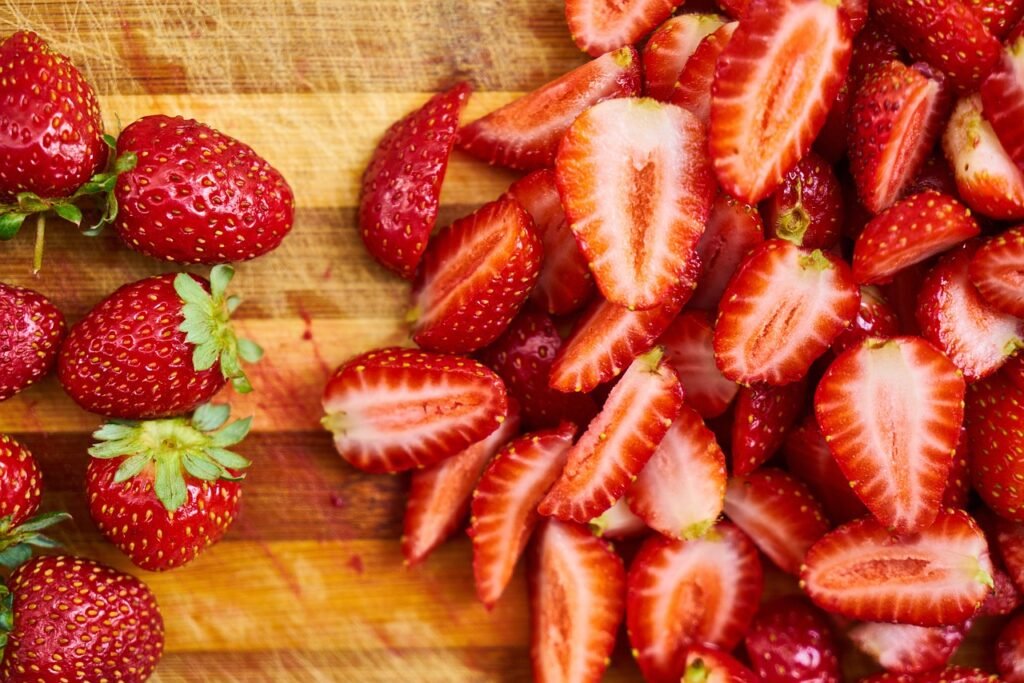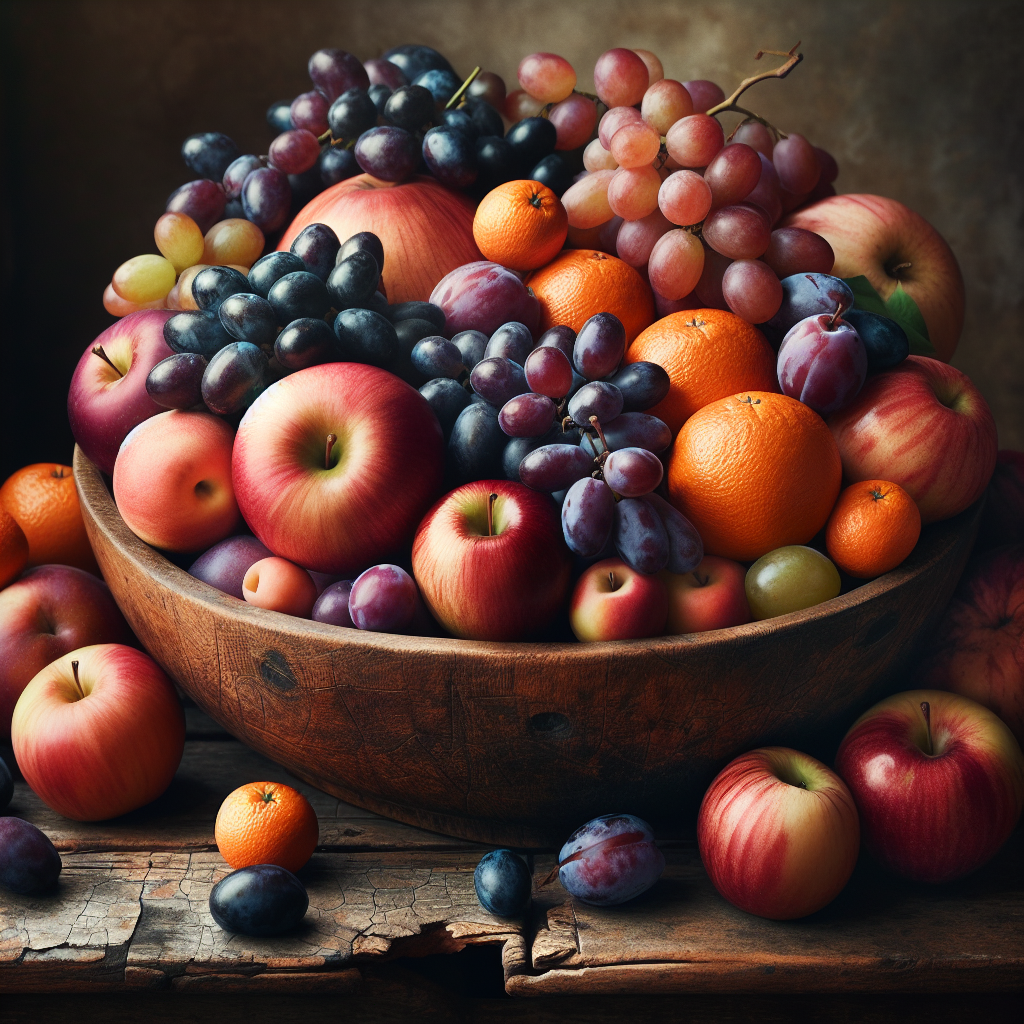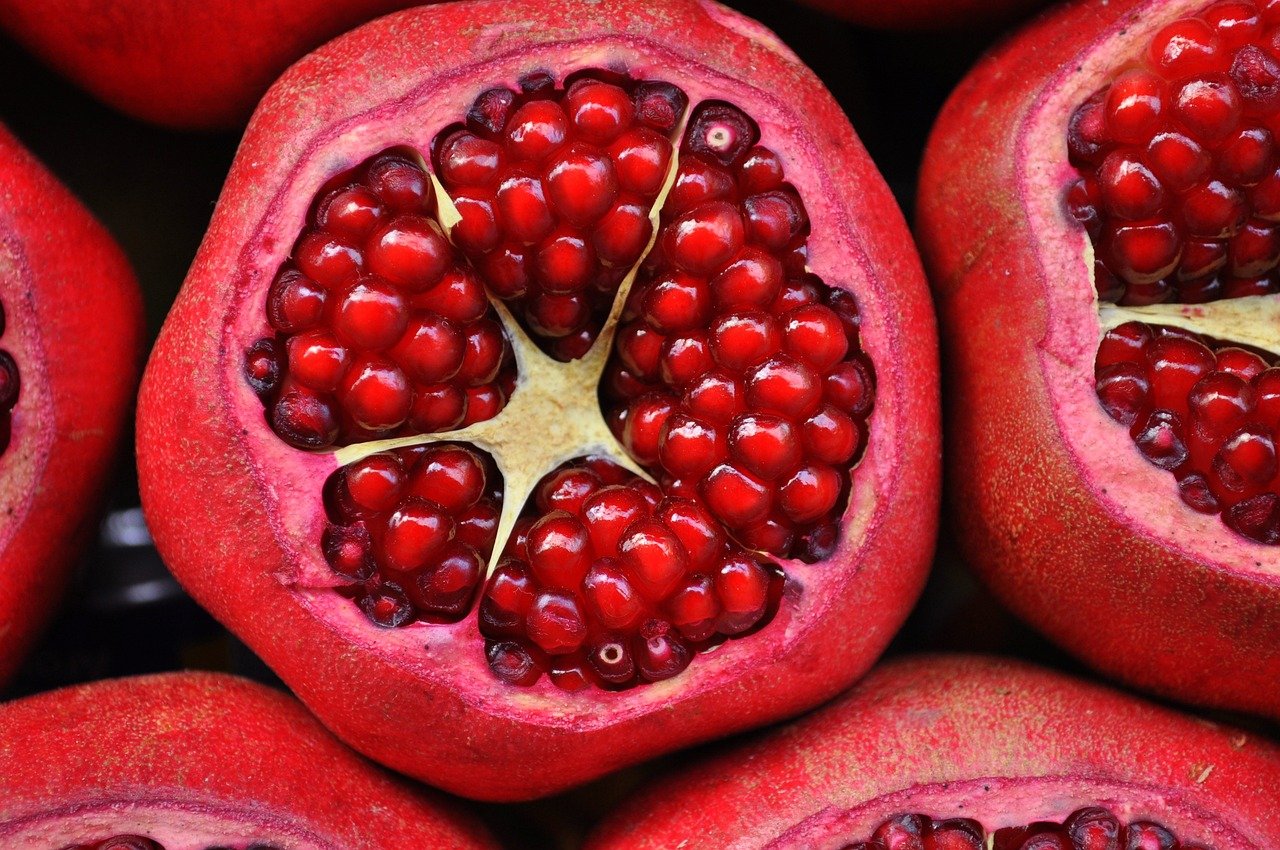September is the month of bountiful harvests, and what better way to celebrate than with an array of delicious fruits? From juicy apples and pears to sweet grapes and plums, September offers an abundance of fruity goodness for you to enjoy. Whether you’re looking to make a refreshing fruit salad, bake a mouthwatering pie, or simply indulge in a healthy snack, this article will guide you through the tantalizing options available for your September harvest. So get ready to savor the flavors of fall and embrace the vibrant and delectable world of September fruits!

1. Apples
Varieties of Apples
When it comes to apples, September is the perfect time to indulge in the abundance of apple varieties available. From the sweet and juicy Honeycrisp to the crisp and tart Granny Smith, there is an apple for every palate. Other popular varieties include the Gala, Fuji, and Pink Lady. Each apple variety offers a unique flavor profile, texture, and level of sweetness. Whether you prefer a sweeter apple for snacking or a tart apple for baking, September is the perfect time to explore the wide variety of apples available.
Harvesting Apples
September marks the beginning of the apple harvesting season. When harvesting apples, it’s important to look for certain signs of ripeness. The easiest way to determine if an apple is ready for harvesting is by giving it a gentle twist. If the apple easily detaches from the tree with a slight twist of the wrist, it is ready to be picked. Additionally, the color of the apple should be vibrant and evenly distributed. Avoid picking apples that have any green or overly ripe spots. Carefully handle each apple while harvesting to prevent bruising or damage.
Tips for Storing Apples
To ensure your apples stay fresh and flavorful for as long as possible, proper storage is key. Store apples in a cool place, preferably in the refrigerator. Apples release ethylene gas, which can cause other fruits and vegetables to spoil more quickly, so it’s best to store them separately. If storing a large quantity of apples, consider wrapping each apple individually in newspaper or storing them in a mesh bag to allow for proper air circulation. Keep an eye on your apples and discard any that show signs of spoiling to prevent the spread of rot to other apples.
Delicious Apple Recipes
With the abundance of apples available in September, it’s the perfect time to experiment with delicious apple recipes. From classic favorites like apple pie and apple crisp to unique creations like caramel apple nachos and apple stuffed acorn squash, the possibilities are endless. Indulge in the comforting flavors of apple cinnamon muffins or enjoy a refreshing apple walnut salad. Get creative in the kitchen and explore the versatility of this beloved fruit in both sweet and savory dishes.
2. Grapes
Types of Grapes
September brings a bountiful harvest of grapes, making it the perfect time to discover the different varieties available. From the popular green Thompson seedless grapes to the richly flavored red Flame Seedless grapes, there is a grape variety to suit every taste. Other varieties to explore include the juicy Concord grapes, the sweet and tangy Muscat grapes, and the unique Cotton Candy grapes, which taste like their namesake. Whether you prefer seedless or seeded grapes, there is a wide range of flavors and textures to enjoy.
When to Harvest Grapes
Knowing when to harvest grapes is crucial to ensure optimal flavor and sweetness. Grapes are typically harvested in September when they reach their peak ripeness. Look for grapes that have reached their full color and have a slight give when gently squeezed. Avoid grapes that are still firm and green, as they may not have fully developed their sugars. It’s important to note that grapes continue to ripen after being harvested, so if you prefer a slightly less sweet taste, you can harvest them a bit earlier.
Pruning Grapevines
Properly pruning grapevines is essential for maintaining healthy plants and maximizing fruit production. September is a great time to start pruning grapevines, as it allows for better air circulation and reduces the risk of disease. Pruning should be done while the vines are dormant during the winter months, but it’s important to prepare in advance. Remove any dead or diseased vines, as well as any suckers that may be stealing nutrients from the main vine. This will promote new growth and ensure a bountiful harvest in the following year.
Ways to Enjoy Fresh Grapes
Freshly harvested grapes are a true delight to enjoy on their own or incorporated into various dishes. Add them to fruit salads, cheese platters, or freeze them for a refreshing and healthy snack. Grapes can also be pressed to make delicious homemade grape juice or fermented into flavorful wines. Explore the versatility of grapes by roasting them with vegetables for a unique flavor combination or juicing them for a refreshing summer beverage. The possibilities are endless when it comes to incorporating fresh grapes into your culinary adventures.

3. Pears
Different Varieties of Pears
September brings a wonderful variety of pears to enjoy, each with its own unique flavor and texture. From the sweet, buttery texture of the Bartlett pear to the crisp and juicy texture of the Anjou pear, there is a pear variety for every taste. Other popular varieties include the Bosc pear with its firm and dense flesh, the aromatic and delicate Comice pear, and the petite and sweet Forelle pear. Each variety offers a different taste experience, from sweet and floral to tangy and refreshing.
How to Tell if Pears are Ripe
Determining the ripeness of pears can be a bit challenging, as they don’t ripen on the tree like some other fruits. To check if a pear is ripe, gently press the neck of the pear near the stem with your thumb. If it gives slightly and feels slightly soft, it is ready to be enjoyed. Avoid pressing the base of the pear, as this area tends to remain firm even when the pear is ripe. If you prefer a softer texture, allow the pears to ripen at room temperature for a few days before consuming.
Harvesting and Caring for Pears
When it comes to harvesting pears, it’s important to pick them at the right time for optimal flavor and texture. Pears should be harvested when they are mature but still firm. They should start to turn from green to yellow or a deeper shade depending on the variety. To harvest pears, gently twist the fruit and lift it straight up, avoiding any jerking motions that could damage the branch. After harvesting, store pears in a cool place, such as a cellar or refrigerator, to extend their shelf life.
Delightful Pear Desserts
Pears lend themselves beautifully to a wide range of delectable desserts. From classic pear tarts and poached pears in red wine to warm pear crumbles and spiced pear galettes, there is no shortage of delicious pear-centered desserts to enjoy in September. For a lighter option, consider grilling pears and serving them with a dollop of Greek yogurt and a drizzle of honey. Alternatively, use pears as a filling for cakes, muffins, or turnovers for a delightful and sweet treat. Let your creativity soar in the kitchen and enjoy the delightful flavors that pears bring to desserts.
4. Plums
Types of Plums
Plums are a delightful fruit that comes in a variety of types, each with its own unique flavor and texture. September is the prime time for harvesting plums, and you can find a range of options to suit your taste. From the sweet and juicy Santa Rosa plum to the tart and tangy Damson plum, there is a plum variety for every palate. Other popular varieties include the Purple Heart plum with its deep purple flesh, the vibrant and sweet Ruby Queen plum, and the firm and aromatic Elephant Heart plum. Explore the flavors and textures of different plum varieties to find your favorite.
Ripeness Indicators
To enjoy plums at their peak flavor, it’s important to know how to determine their ripeness. Gently squeeze the plums with your fingers – a ripe plum should give slightly under the pressure without feeling mushy. The skin should also have a deep, vibrant color, depending on the variety. Avoid plums that are still firm or have any greenish patches, as they may not be fully ripe. Plums that are slightly soft to the touch and have an enticing aroma are perfect for immediate consumption or using in recipes.
Harvesting and Pruning Plum Trees
September is the ideal time to harvest plums, as they reach their peak ripeness. When harvesting plums, gently twist the fruit and lift it straight up, being careful not to damage the branch. If the plum detaches easily, it is ready to be picked. Avoid pulling or tugging the fruit, as this can cause damage to the tree. Proper pruning is essential for healthy plum trees and a bountiful harvest. Prune plum trees during their dormant period in late winter or early spring to remove dead, damaged, or crossing branches.
Plum-based Drinks and Snacks
Plums are not only delicious when enjoyed fresh, but they can also be used to create a variety of enticing beverages and snacks. Make a refreshing plum lemonade by blending ripe plums with fresh lemon juice and sweetener of your choice. Infuse a bottle of vodka with sliced plums for a unique and flavorful homemade plum liqueur. Alternatively, dry plums in a dehydrator or oven to make tasty plum chips, a healthy and satisfying snack. Experiment with plum-based salsa, plum butter, or even plum-infused ice cream for a delightful twist on traditional flavors.

5. Peaches
Varieties of Peaches
September is the perfect time to enjoy the juicy and fragrant peaches that are in season. From the classic yellow-fleshed Elberta peach to the sweet and tangy white-fleshed Georgia Belle peach, there is a peach variety to suit every taste preference. Other popular peach varieties include the clingstone Red Haven peach, the freestone Suncrest peach, and the heirloom Indian Blood peach known for its vibrant red flesh. Each variety brings its own unique flavor and texture, making peach season in September a truly delightful time for peach lovers.
Determining Peach Ripeness
Knowing when a peach is perfectly ripe can be a bit tricky. To determine if a peach is ripe, give it a gentle squeeze – it should yield slightly under the pressure without feeling too soft. The color of the peach should also be vibrant, ranging from creamy yellows to deep oranges, depending on the variety. Avoid peaches that are still firm to the touch or are green in color as they may not have reached their peak ripeness. Additionally, peaches should have a sweet and distinctive aroma when they are ripe.
Harvesting and Preserving Peaches
Peaches are best harvested when they are fully ripe to ensure the best flavor. To harvest peaches, gently twist and lift the fruit upwards, avoiding any jerking motions that could damage the tree or the fruit. If the peach detaches easily from the branch, it is ready to be picked. To preserve the harvest, consider freezing peaches for future use. Blanch peaches in boiling water for a few seconds, then transfer to an ice bath to cool. Once cooled, remove the skin, slice the peaches, and freeze them in a single layer before transferring to freezer bags.
Enjoying Fresh Peaches in Recipes
The versatility of peaches allows for endless culinary creations in the kitchen. Slice fresh peaches and add them to salads for a burst of juicy sweetness, or grill them to bring out their natural caramelized flavor. Create a refreshing peach salsa or chutney to complement grilled meats or enjoy them simply sliced and served with a dollop of whipped cream. For a sweet treat, bake a peach cobbler or whip up some peach preserves to spread on toast or biscuits. The options are limitless when it comes to incorporating fresh peaches into your favorite recipes.
6. Figs
Different Types of Figs
Figs are a unique fruit that comes in a variety of types, each with its own distinct flavor and texture. September is the prime time to indulge in the delightful world of figs. From the sweet and jammy Black Mission fig to the pale and delicately flavored Kadota fig, there is a fig variety to suit every taste bud. Other popular varieties include the rich and honey-like Calimyrna fig, the robust and sweet Brown Turkey fig, and the petite and sweet Adriatic fig. Each fig variety offers a unique taste experience, making them a beloved fruit among food enthusiasts.
When to Harvest Figs
Fig trees produce two crops per year, with the second crop typically ripening in September. To determine if figs are ready to be harvested, gently squeeze the fruit – a ripe fig should yield slightly under gentle pressure. The color of the figs should be vibrant and have a natural shine. Figs that have slightly drooped on the tree are a good indication that they are ripe. It’s important to harvest figs as soon as they ripen, as they have a short shelf life once picked.
Caring for Fig Trees
Caring for fig trees is essential for maintaining healthy and productive plants. Figs thrive in warm climates and require full sun and well-drained soil. Regular watering is important, especially during the fruiting season, to ensure optimal growth and production. Pruning fig trees during the dormant season in late winter or early spring helps maintain shape and encourages new growth. Remove any dead or diseased branches, as well as any congested growth or crossing branches. Proper care and maintenance will ensure a bountiful fig harvest year after year.
Tasty Fig-based Dishes
Figs lend themselves perfectly to a variety of delicious dishes, both sweet and savory. Wrap fresh figs with prosciutto for an elegant and simple appetizer, or stuff them with goat cheese and drizzle with honey for a sweet and savory delight. Incorporate figs into salads for a burst of sweetness, or simmer them with balsamic vinegar and spices for a fragrant fig compote. For a delightful dessert, bake figs in puff pastry with a sprinkle of cinnamon and sugar, or poach them in red wine for an indulgent treat. Let the unique flavor of figs shine in your culinary creations.

7. Blackberries
Best Blackberry Varieties
Blackberries are a delicious late-summer treat, and September is the prime time for their harvest. When it comes to blackberries, there are several varieties known for their exceptional flavor. The Marion blackberry, with its intense sweetness and deep purple color, is a popular choice among blackberry enthusiasts. The Thornless Evergreen blackberry offers a thornless option with a rich and complex flavor. Other notable varieties include the Black Diamond blackberry with its large and sweet berries, and the Ouachita blackberry, which is known for its disease resistance and firm berries.
Ripeness Signs
Determining the ripeness of blackberries is crucial to ensure optimal flavor and sweetness. Ripe blackberries should be plump, shiny, and uniformly black. Avoid picking blackberries that are still red or partially red, as they may not have fully ripened and may be tart or less flavorful. The berries should be slightly soft to the touch, but not mushy. When harvesting blackberries, gently lift the berry and if it detaches easily without resistance, it is ready to be picked. Handle blackberries with care to avoid squishing the delicate fruit.
Harvesting and Pruning Blackberry Bushes
September is the opportune time to harvest blackberries when they are at their peak ripeness. To harvest blackberries, gently pluck the berries from the plant, being careful not to crush them. It’s best to harvest blackberries in the morning when the temperature is cooler, as they are less likely to become overripe or attract insects. Proper pruning of blackberry bushes is essential for maintaining healthy plants and increasing productivity. Prune blackberry bushes during the dormant season by removing the old, non-productive canes and leaving the young, vigorous canes to fruit the following year.
Blackberry Treats and Snacks
Blackberries can be enjoyed in a variety of delightful treats and snacks. Toss them in salads or yogurt for a burst of sweet-tart flavor, or blend them into smoothies for a refreshing and nutritious drink. Indulge in a blackberry cobbler or crumble for a warm and comforting dessert, or bake them into muffins or pancakes for a delightful breakfast treat. Blackberries can also be transformed into homemade jams, sauces, and syrups for drizzling over ice cream or adding to cocktails. Whether enjoyed fresh or incorporated into various recipes, blackberries are a versatile fruit that brings a burst of flavor to any dish.
8. Melons
Varieties of Melons
September brings an abundance of melons, each with its own unique flavor and characteristics. From the juicy and sweet watermelon to the fragrant and honey-like cantaloupe, there is a melon variety to suit every taste preference. Other popular melon varieties include the crisp and refreshing honeydew melon, the aromatic and tropical muskmelon, and the unique and vibrant canary melon. Each melon variety offers a different taste experience, making them a staple fruit of late summer.
Determining Melon Ripeness
Determining the ripeness of melons can be a bit challenging, as they do not continue to ripen once harvested like some other fruits. When it comes to watermelons, look for a yellow spot on the underside of the melon – this indicates where the melon has been resting on the ground and is a sign of ripeness. Additionally, thump the watermelon – if it sounds hollow, it is likely ripe. For cantaloupes and honeydews, give the melon a gentle press near the stem end – if it gives slightly and has a sweet aroma, it is ready to be enjoyed.
Harvesting and Storing Melons
Melons are typically harvested when they are fully ripe to ensure optimal flavor and sweetness. When harvesting melons, cut the stem about an inch above the fruit using a sharp knife. Twisting or pulling the melon can cause damage to the plant or fruit. Avoid harvesting melons too early, as they will not ripen further once picked. Once harvested, melons should be stored in a cool and dry place, away from direct sunlight. Store them separately from other fruits and vegetables to prevent the spread of ethylene gas, which can cause premature ripening.
Refreshing Melon Smoothies and Salads
Melons are a refreshing and hydrating fruit that can be enjoyed in a variety of ways. Blend chunks of ripe melon with yogurt, ice, and a splash of citrus juice for a refreshing and nutritious smoothie. Add diced melon to summer salads for a burst of natural sweetness and a pop of color. Consider pairing melon with prosciutto or cheese for a savory-sweet combination that is sure to please. For a unique twist, hollow out a melon and use it as a serving vessel for chilled soups or fruit salads. Embrace the juicy sweetness of melons and let your taste buds savor the late summer flavors.

9. Kiwis
Different Types of Kiwis
Kiwis are a unique and flavorful fruit that is in season in September. There are several varieties of kiwis, each with its own distinct flavor and appearance. The most common variety is the fuzzy kiwi, which has a brown, fuzzy skin and a tangy-sweet flesh. The golden kiwi, on the other hand, has a smooth, yellow skin and a sweeter and less tangy flavor. Another variety to explore is the baby kiwi, also known as kiwi berries, which are small, smooth-skinned, and bite-sized. Each variety offers a different taste experience, making kiwis a delightful addition to September’s harvest.
When to Harvest Kiwis
Kiwis are typically harvested in late summer or early fall when they have reached their peak ripeness. To determine if a kiwi is ready to be harvested, gently press the fruit – it should yield slightly under the pressure without feeling too soft. Kiwis that have a vibrant color and are slightly fragrant are a good indication of ripeness. It’s important to harvest kiwis before the first frost, as they are sensitive to cold temperatures. Kiwis can continue to ripen after being picked, but they should have reached their mature size and color before being harvested.
Caring for Kiwi Vines
Growing and caring for kiwi vines requires some attention and care, but the reward is worth it. Kiwi vines thrive in well-draining soil and full sun or partial shade. They require a trellis or support system to grow on, as they are vigorous climbers. Pruning is essential for maintaining healthy and productive plants. Prune kiwi vines during the dormant season in late winter or early spring to remove dead or overcrowded branches. It’s also important to thin out the fruit in the early stages to ensure optimal growth and size.
Incorporating Kiwis into Recipes
Kiwis are a versatile fruit that can be incorporated into a variety of recipes. Peel and slice kiwis to add a pop of color and tangy sweetness to fruit salads or smoothie bowls. Blend kiwis into refreshing summer drinks, such as kiwi lemonade or kiwi mojitos. Create a vibrant and flavorful salsa by combining kiwis with diced tomatoes, onions, jalapenos, and a squeeze of lime juice. For a sweet treat, make a kiwi tart or kiwi sorbet. Embrace the tropical flavors of kiwis and let your imagination run wild in the kitchen.
10. Raspberries
Types of Raspberries
Raspberries are a delightful fruit that reaches its peak in September. There are two main types of raspberries – summer-bearing and everbearing. Summer-bearing raspberries produce fruit once a year, typically in early to mid-summer. Everbearing raspberries, as the name suggests, produce fruit twice a year – once in summer and again in late summer or early fall. Both types offer a burst of sweet-tart flavor, with summer-bearing raspberries typically being larger and juicier. Explore the varieties within each type, such as the popular red raspberry or the golden raspberry, to find your preferred raspberry experience.
Ripeness Indicators
Determining the ripeness of raspberries is essential for enjoying them at their peak flavor. Raspberries should be plump, firm, and fully colored. Avoid picking raspberries that are still red or have any green patches, as they may not have fully ripened and may be tart or less flavorful. Ripe raspberries should easily detach from the plant when gently plucked without any resistance. Be careful when handling raspberries, as they are delicate and can quickly turn mushy or bruise.
Harvesting and Pruning Raspberry Canes
Raspberries are best harvested in the morning when the berries are cool and firm. When harvesting raspberries, gently pluck the ripe berries from the plant, being careful not to squash them. It’s best to hold the berry by its stem and gently twist it off the plant. Raspberries should be consumed promptly after picking to ensure optimal freshness and flavor. Pruning raspberry canes is important for maintaining healthy plants and maximizing fruit production. Prune summer-bearing raspberries after the fruiting season, removing the canes that have fruited and leaving the fresh canes for next year’s harvest.
Berrylicious Raspberry Treats
Raspberries are a versatile fruit that can be enjoyed in a variety of tasty treats. Add raspberries to oatmeal or yogurt for a burst of fruity sweetness, or blend them into smoothies for a refreshing and antioxidant-rich drink. Create a raspberry coulis or sauce to drizzle over ice cream or cheesecake for a delightful dessert. Use raspberries as a topping for pancakes, waffles, or French toast to brighten up your breakfast. For a more decadent treat, bake a raspberry chocolate tart or whip up a batch of raspberry macarons. Allow the vibrant flavors of raspberries to shine in your culinary creations.

